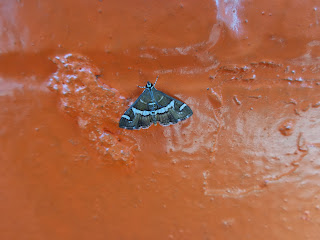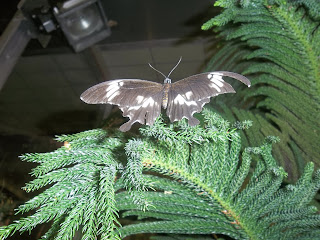Vespula maculifrons Queen which may or may not have been still kicking 12-28-13
They were amazing.......last and latest bug hunt of the year. The latest they were out was in November 2011......felt like Spring that day. Today it felt like Spring yet again and I was greatly awarded with all sorts of birds and assorted creepy crawlies.......and a surprise from my lepidopteran friends.
I had originally gone to the park to look for cocoons of various moths.....and maybe butterfly chrysalids or overwintering Polygonia spp. or Nymphalis antiopa and while I didn't find any of those.........I DID find something of a mystery lodged in one of the normally bug infested logs.
Mystery moth pupae 12-28-13
I wonder what exactly made this......so many many possibilities.
It was discussed via facebook & twitter and the possibilities are endless.....
Woodboring Erebidae
Notodontidae (Cerura and Furcula spp. specifically)
Cossidae (Prionoxystus robiniae)
To name a few of what it could be........Notodontids of the genera Cerura & Furcula I haven't seen here in any shape or form nor have I seen Prionoxystus robiniae or any of the other 3 Eastern N. American Cossidae. The pupa wasn't "large" by any means......but it wasn't "small" either. Medium? And skinny....but not too skinny.
Providing the weather is nice again after the snow we're supposed to get in a few days. I'll go back and see if it's still there and try and get better pics and maybe try and get it out. I tried but it seemed like it was stuck in there pretty tightly.
Silken pads most likely......and the added protection of a deep enough notch in a log. ^^* Another question though is when did it emerge? Last time I was there (Oct 15th) I didn't see it there but then again I wasn't looking for cocoons or pupae/chrysalids then since the adults of various lepidopterans were out pollinating the last of the flowers.
My only guess it that it was over looked. It wouldn't make sense for it to have crawled in there say late/early October pupated and then emerged on an abnormally warm Autumn/winter day only to eventually freeze to death. Don't have the climate for them to do that "successfully".
But I wouldn't rule anything out at this point. But the possibility of it being overlooked is more likely. Hope to find more this year......♥
Some kind of ground beetle?
No clue!! Was a shock to find this and many others zipping about. Midges/craneflies (these were in some sort of swarm) another beetle in flight, slugs, milipedes, centipedes.......woodlice. Oh it was wonderful not to mention the birds.
Juncos!! Some friends had confirmed these are juncos and I had also learned that there might be a junco species complex (Idk if that would be the right term here but Idk that much about birds to begin with) since the "experts had lumped them all together" so to speak according to said friends.
Aren't they just darling little things? Here's another:
I have many more but I'll post those in another post as once again I've probably ranted enough about my precious lovely little friends.....but I can't help it. *^^*
Until next time.
ɛïɜ
They were amazing.......last and latest bug hunt of the year. The latest they were out was in November 2011......felt like Spring that day. Today it felt like Spring yet again and I was greatly awarded with all sorts of birds and assorted creepy crawlies.......and a surprise from my lepidopteran friends.
I had originally gone to the park to look for cocoons of various moths.....and maybe butterfly chrysalids or overwintering Polygonia spp. or Nymphalis antiopa and while I didn't find any of those.........I DID find something of a mystery lodged in one of the normally bug infested logs.
Mystery moth pupae 12-28-13
I wonder what exactly made this......so many many possibilities.
It was discussed via facebook & twitter and the possibilities are endless.....
Woodboring Erebidae
Notodontidae (Cerura and Furcula spp. specifically)
Cossidae (Prionoxystus robiniae)
To name a few of what it could be........Notodontids of the genera Cerura & Furcula I haven't seen here in any shape or form nor have I seen Prionoxystus robiniae or any of the other 3 Eastern N. American Cossidae. The pupa wasn't "large" by any means......but it wasn't "small" either. Medium? And skinny....but not too skinny.
Providing the weather is nice again after the snow we're supposed to get in a few days. I'll go back and see if it's still there and try and get better pics and maybe try and get it out. I tried but it seemed like it was stuck in there pretty tightly.
Silken pads most likely......and the added protection of a deep enough notch in a log. ^^* Another question though is when did it emerge? Last time I was there (Oct 15th) I didn't see it there but then again I wasn't looking for cocoons or pupae/chrysalids then since the adults of various lepidopterans were out pollinating the last of the flowers.
My only guess it that it was over looked. It wouldn't make sense for it to have crawled in there say late/early October pupated and then emerged on an abnormally warm Autumn/winter day only to eventually freeze to death. Don't have the climate for them to do that "successfully".
But I wouldn't rule anything out at this point. But the possibility of it being overlooked is more likely. Hope to find more this year......♥
Some kind of ground beetle?
No clue!! Was a shock to find this and many others zipping about. Midges/craneflies (these were in some sort of swarm) another beetle in flight, slugs, milipedes, centipedes.......woodlice. Oh it was wonderful not to mention the birds.
Juncos!! Some friends had confirmed these are juncos and I had also learned that there might be a junco species complex (Idk if that would be the right term here but Idk that much about birds to begin with) since the "experts had lumped them all together" so to speak according to said friends.
Aren't they just darling little things? Here's another:
I have many more but I'll post those in another post as once again I've probably ranted enough about my precious lovely little friends.....but I can't help it. *^^*
Until next time.
ɛïɜ








































.jpg)


